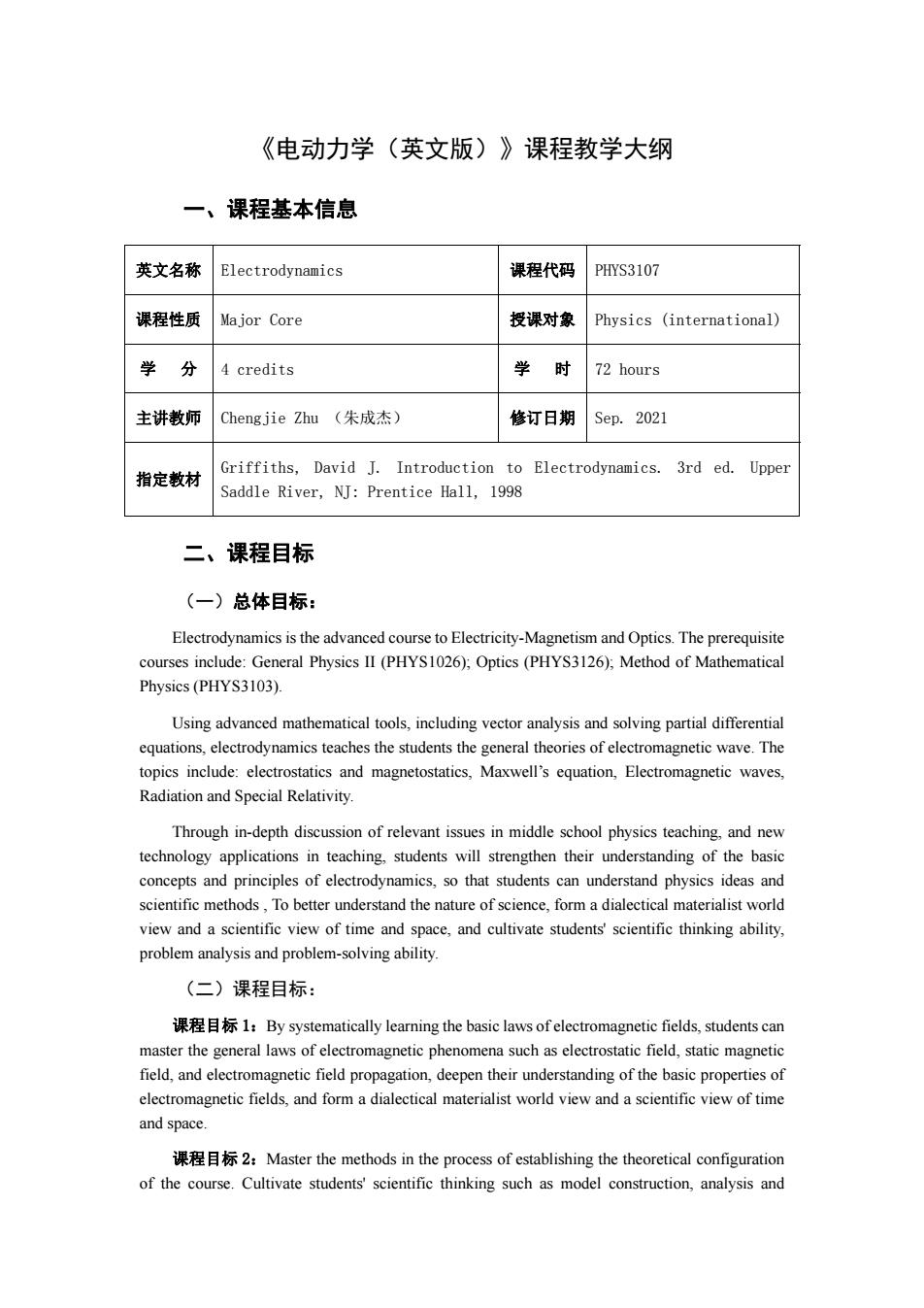
《电动力学(英文版)》课程教学大纲 一、课程基本信息 英文名称Electrodynamics 课程代码 PHYS3107 课程性质Major Core 授课对象 Physics (international) 学分 4 credits 学时 72 hours 主讲教师 Chengjie Zhu(朱成杰) 修订日期 Sep.2021 指定教材 Griffiths,David J.Introduction to Electrodynamics.3rd ed.Upper Saddle River,NJ:Prentice Hall,1998 二、课程目标 (一)总体目标: is the i-Mnetimnd The courses include:General Physics II(PHYS1026).Optics(PHYS3126),Method of Mathematical Physics(PHYS3103). Using advanced mathematical tools.including vector analysis and solving partial differential teaches the students the eral theores of ele magnetic wave.The topics include: electrostatics and magnetostatics,Maxwell'sq Electromagnetic waves. Radiation and Special Relativity. Through in-depth discussion of relevant issues in middle school physics teaching.and new technology applications in teaching.students will strengthen their understanding of the basic view and a scientific view of time and space,and cultivate students'scientific thinking ability. problem analysis and problem-solving ability. (二)课程目标: i课程目标l:By systematically eaming the basic aws fields,studentsca mas ster the general laws of electromagnetic phenomena such as electrostatic field,static magneti field,and electromagnetic field propagation,deepen their understanding of the basic properties of electromagnetic fields,and form a dialectical materialist world view and a scientific view of time and space. of the cours.Cultivate students thinking such as,analysis and
《电动力学(英文版)》课程教学大纲 一、课程基本信息 英文名称 Electrodynamics 课程代码 PHYS3107 课程性质 Major Core 授课对象 Physics (international) 学 分 4 credits 学 时 72 hours 主讲教师 Chengjie Zhu (朱成杰) 修订日期 Sep. 2021 指定教材 Griffiths, David J. Introduction to Electrodynamics. 3rd ed. Upper Saddle River, NJ: Prentice Hall, 1998 二、课程目标 (一)总体目标: Electrodynamics is the advanced course to Electricity-Magnetism and Optics. The prerequisite courses include: General Physics II (PHYS1026); Optics (PHYS3126); Method of Mathematical Physics (PHYS3103). Using advanced mathematical tools, including vector analysis and solving partial differential equations, electrodynamics teaches the students the general theories of electromagnetic wave. The topics include: electrostatics and magnetostatics, Maxwell’s equation, Electromagnetic waves, Radiation and Special Relativity. Through in-depth discussion of relevant issues in middle school physics teaching, and new technology applications in teaching, students will strengthen their understanding of the basic concepts and principles of electrodynamics, so that students can understand physics ideas and scientific methods , To better understand the nature of science, form a dialectical materialist world view and a scientific view of time and space, and cultivate students' scientific thinking ability, problem analysis and problem-solving ability. (二)课程目标: 课程目标 1:By systematically learning the basic laws of electromagnetic fields, students can master the general laws of electromagnetic phenomena such as electrostatic field, static magnetic field, and electromagnetic field propagation, deepen their understanding of the basic properties of electromagnetic fields, and form a dialectical materialist world view and a scientific view of time and space. 课程目标 2:Master the methods in the process of establishing the theoretical configuration of the course. Cultivate students' scientific thinking such as model construction, analysis and
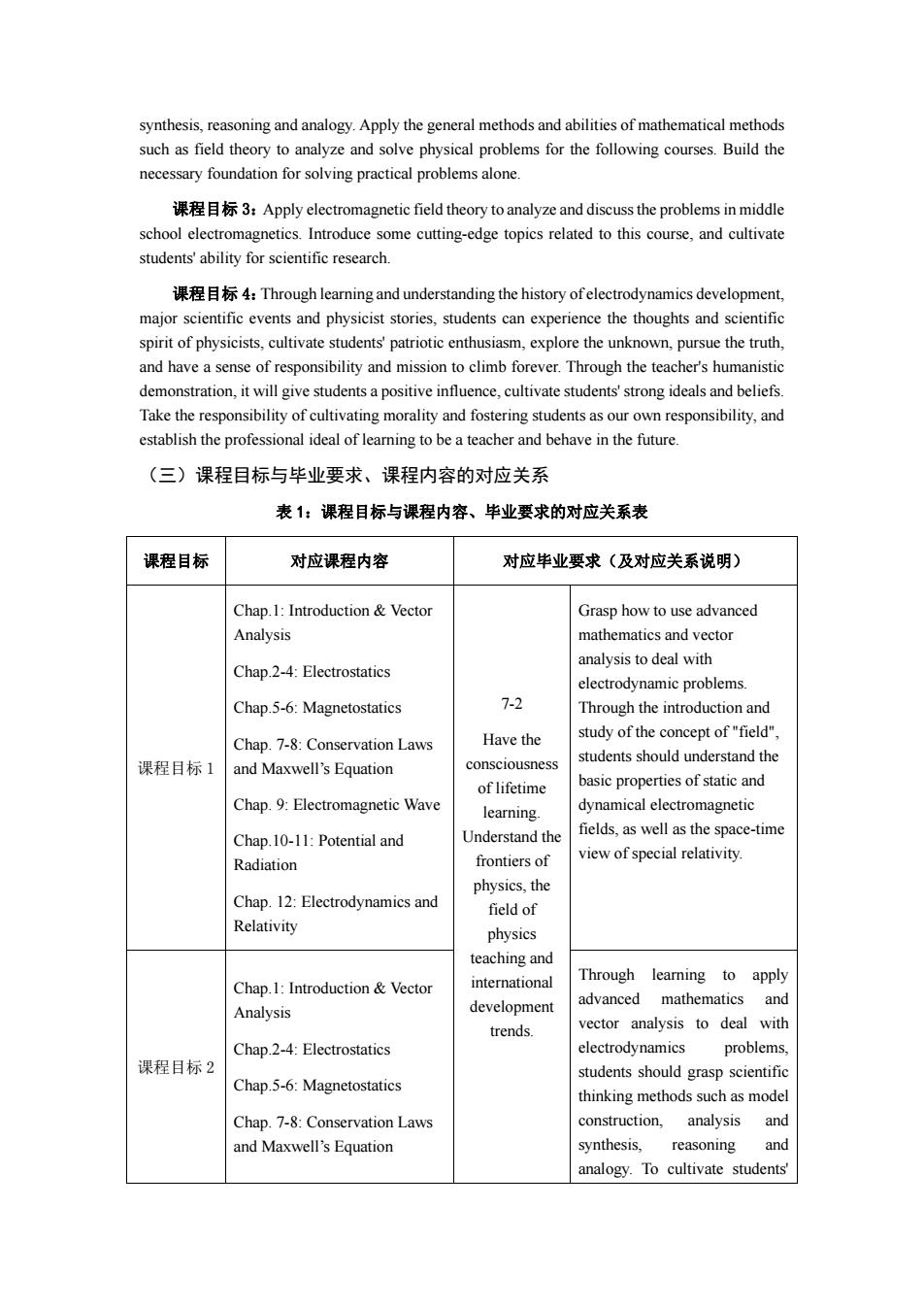
synthesis,reasoning and analogy.Apply the general methods and abilities of mathematical methods such as field theory to analyze and solve physical problems for the following courses.Build the foundation for soving practical 课程目标3:Apply electromagnetic field theory to analyze and discuss the problems inmiddl school electromagnetics.Introduce some cutting-edge topics related to this course,and cultivate students'ability for scientific research. 课程目标4 Through and understanding the history developmen major events and physicist stories,students can the thoughts and spirit of physicists,cultivate students'patriotic enthusiasm,explore the unknown,pursue the truth and have a sense of responsibility and mission to climb forever.Through the teacher's humanistic demonstration,it will give students a positive influence,cultivate students'strong ideals and beliefs. Take the responsibility of cultivating morality and fostering students asou own responsibility,and establish the professional ideal of leaming to bea teacher and behave in the future (三)课程目标与毕业要求、课程内容的对应关系 表1:课程目标与课程内容、单业要求的对应关系表 课程目标 对应课程内容 对应毕业要求(及对应关系说明) Chap.1:Introduction Vector Grasp how to use advanced Analysis mathematics and vector analysis to deal with Chap.2-4:Electrostatics problem Chap5-:Magnetostatics 7-2 Through the introductionan Have the study of the concept of "field" Chap.7-8:Conservation Laws students should understand the 课程目标1 and Maxwel's Equation consciousness of lifetime basic properties of static and Chap.9:Electromagnetic Wave learning. Chap.10-11:Potential and Understand the fields.as well as the space-tim view of special relativity. Radiation physics.the Chap.12:Electrodynamics and field of Relativity physics teaching and Chap.1:Introduction Vector Through learning to apply Analysis development advanced mathematics and vector analysis to deal with trends. Chap2-:Electrostatics electrodynamics problems 课程目标2 Chap5-:Magnetostatics students should grasp thinking methods such as mode Chap.7-8:Conservation Laws construction.analysis and and Maxwell's Equation synthesis, reasoning and analogy.To cultivate students
synthesis, reasoning and analogy. Apply the general methods and abilities of mathematical methods such as field theory to analyze and solve physical problems for the following courses. Build the necessary foundation for solving practical problems alone. 课程目标 3:Apply electromagnetic field theory to analyze and discuss the problems in middle school electromagnetics. Introduce some cutting-edge topics related to this course, and cultivate students' ability for scientific research. 课程目标 4:Through learning and understanding the history of electrodynamics development, major scientific events and physicist stories, students can experience the thoughts and scientific spirit of physicists, cultivate students' patriotic enthusiasm, explore the unknown, pursue the truth, and have a sense of responsibility and mission to climb forever. Through the teacher's humanistic demonstration, it will give students a positive influence, cultivate students' strong ideals and beliefs. Take the responsibility of cultivating morality and fostering students as our own responsibility, and establish the professional ideal of learning to be a teacher and behave in the future. (三)课程目标与毕业要求、课程内容的对应关系 表 1:课程目标与课程内容、毕业要求的对应关系表 课程目标 对应课程内容 对应毕业要求(及对应关系说明) 课程目标 1 Chap.1: Introduction & Vector Analysis Chap.2-4: Electrostatics Chap.5-6: Magnetostatics Chap. 7-8: Conservation Laws and Maxwell’s Equation Chap. 9: Electromagnetic Wave Chap.10-11: Potential and Radiation Chap. 12: Electrodynamics and Relativity 7-2 Have the consciousness of lifetime learning. Understand the frontiers of physics, the field of physics teaching and international development trends. Grasp how to use advanced mathematics and vector analysis to deal with electrodynamic problems. Through the introduction and study of the concept of "field", students should understand the basic properties of static and dynamical electromagnetic fields, as well as the space-time view of special relativity. 课程目标 2 Chap.1: Introduction & Vector Analysis Chap.2-4: Electrostatics Chap.5-6: Magnetostatics Chap. 7-8: Conservation Laws and Maxwell’s Equation Through learning to apply advanced mathematics and vector analysis to deal with electrodynamics problems, students should grasp scientific thinking methods such as model construction, analysis and synthesis, reasoning and analogy. To cultivate students
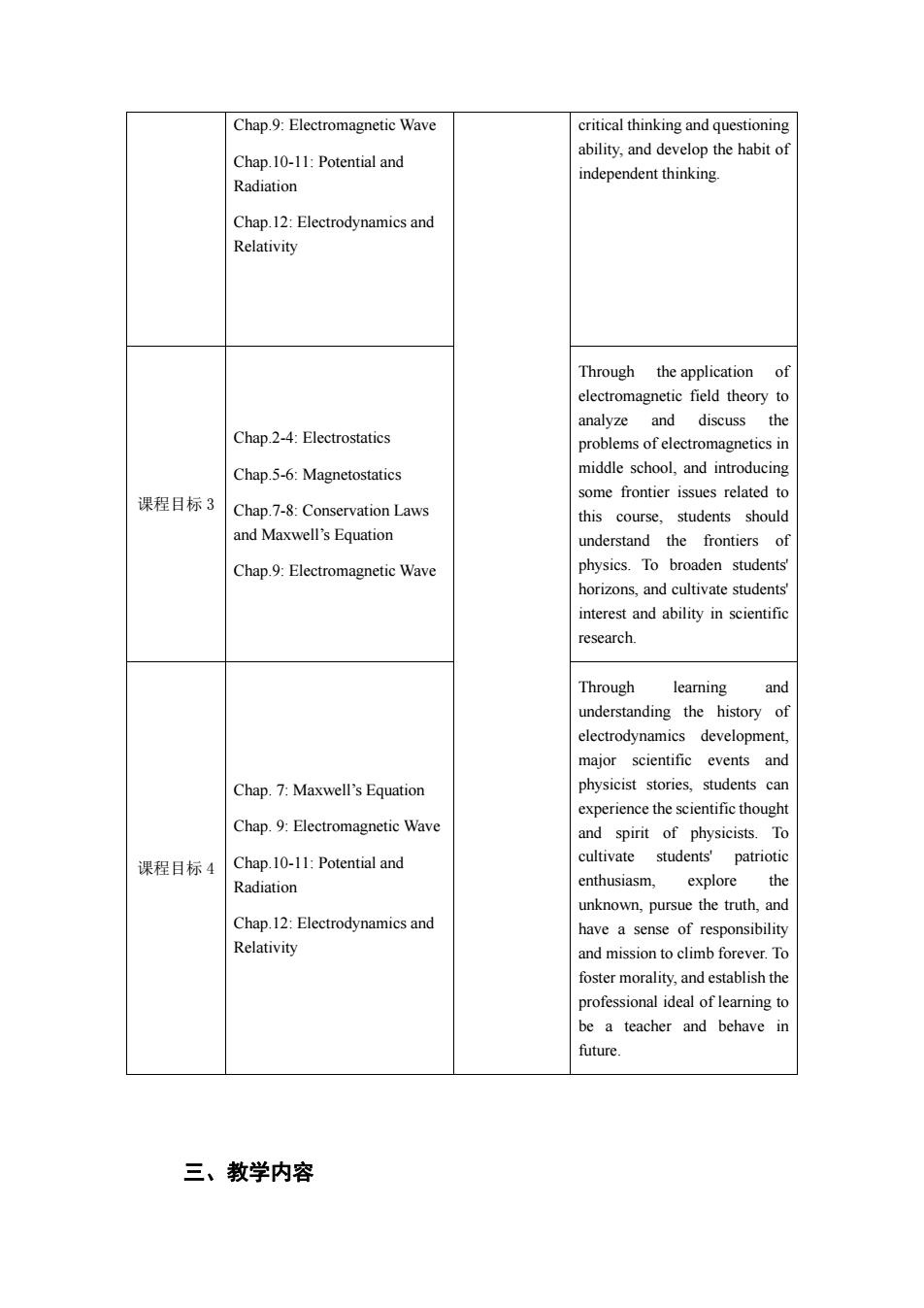
Chap.9:Electromagnetic Wave critical thinking and questioning Chap.10-11:Potential and ability,and developthe habit Radiation ndependent thinking Chap.12:Electrodynamics and Relativity Through the application electromagnetic field theory to analyze and discuss the Chap2-:Electrostatics problems ofelectromagnetics in Chap.5-:Magnetostatics middle school,and introducing 课程目标 some frontier issues related to Chap 7-8:Conservation Laws this course, students should and Maxwell's Equation understand the frontiers of Chap.9:Electromagnetic Wave physics.To broaden students horizons,and cultivate students interest and ability in scientific research. Through learning and understanding the history of electrodynamics development. major scientific events and Chap.7:Maxwell's Equation physicist stories,students can Chap.9:Electromagnetic Wave experience the scientific thought and spirit of physicists.To 课程目标4Chap.l0-Il:Potential and cultivate studentspatriotic Radiation enthusiasm, explore the Chap.12:Electrodynamics and have a sense of responsibility Relativity and mission to climb forever.To foster morality,and establish the professional ideal of learning to be a teacher and behave future 三、教学内容
Chap.9: Electromagnetic Wave Chap.10-11: Potential and Radiation Chap.12: Electrodynamics and Relativity critical thinking and questioning ability, and develop the habit of independent thinking. 课程目标 3 Chap.2-4: Electrostatics Chap.5-6: Magnetostatics Chap.7-8: Conservation Laws and Maxwell’s Equation Chap.9: Electromagnetic Wave Through the application of electromagnetic field theory to analyze and discuss the problems of electromagnetics in middle school, and introducing some frontier issues related to this course, students should understand the frontiers of physics. To broaden students' horizons, and cultivate students' interest and ability in scientific research. 课程目标 4 Chap. 7: Maxwell’s Equation Chap. 9: Electromagnetic Wave Chap.10-11: Potential and Radiation Chap.12: Electrodynamics and Relativity Through learning and understanding the history of electrodynamics development, major scientific events and physicist stories, students can experience the scientific thought and spirit of physicists. To cultivate students' patriotic enthusiasm, explore the unknown, pursue the truth, and have a sense of responsibility and mission to climb forever. To foster morality, and establish the professional ideal of learning to be a teacher and behave in future. 三、教学内容
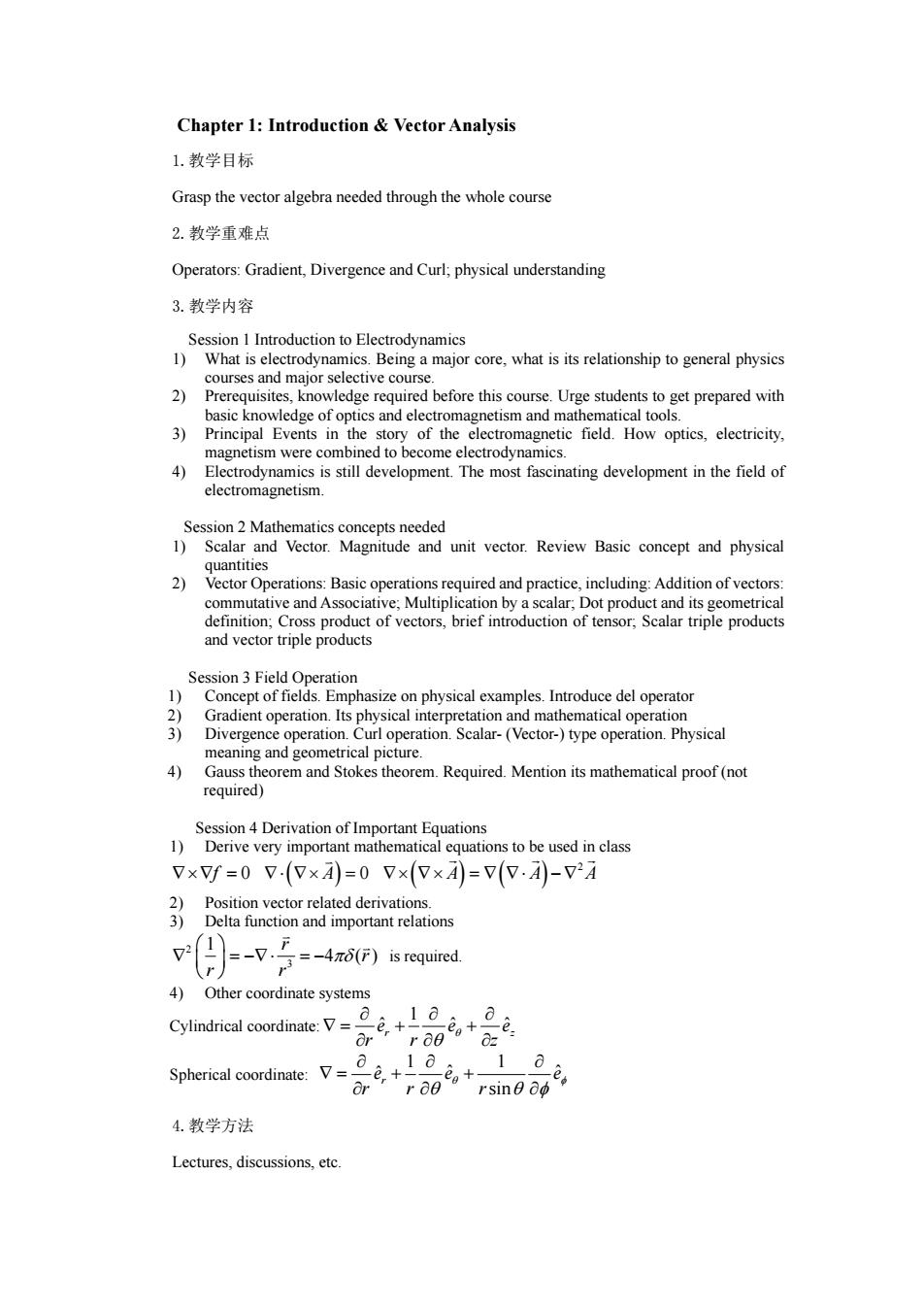
Chapter 1:Introduction Vector Analysis 1.教学目标 Grasp the vector algebra needed through the whole course 2.教学重难点 Operators:Gradient.Divergence and Curl:physical understanding 3.教学内容 2) 3)Principal Events in the story of the tromagnetic field.How optics.electricity. re co rody 4④ nating development in the field of 1 ve Revic hale conp n 2 Math 2) o Additio 一caneaorCfpeOoaleitofectors.bicfntotdctionofienotscalrtpitepotdhcts roduce del operator Divergence operation.Curl operation.Scalar-(Vector-)type operation.Physical 4) eanin g and gec eorem.Required.Mention its mathematical proof(no required) 7×=0(×A)=0V×(×A)=(.A)-A Position vector related derivation Delta function and important relations /-. .3 --4πd(f)is required 4) Other coordinate system Cylindrical coordinate: 88* 10 r0g%+ sin 4.教学方法 Lectures,discussions,etc
Chapter 1: Introduction & Vector Analysis 1.教学目标 Grasp the vector algebra needed through the whole course 2.教学重难点 Operators: Gradient, Divergence and Curl; physical understanding 3.教学内容 Session 1 Introduction to Electrodynamics 1) What is electrodynamics. Being a major core, what is its relationship to general physics courses and major selective course. 2) Prerequisites, knowledge required before this course. Urge students to get prepared with basic knowledge of optics and electromagnetism and mathematical tools. 3) Principal Events in the story of the electromagnetic field. How optics, electricity, magnetism were combined to become electrodynamics. 4) Electrodynamics is still development. The most fascinating development in the field of electromagnetism. Session 2 Mathematics concepts needed 1) Scalar and Vector. Magnitude and unit vector. Review Basic concept and physical quantities 2) Vector Operations: Basic operations required and practice, including: Addition of vectors: commutative and Associative; Multiplication by a scalar; Dot product and its geometrical definition; Cross product of vectors, brief introduction of tensor; Scalar triple products and vector triple products Session 3 Field Operation 1) Concept of fields. Emphasize on physical examples. Introduce del operator 2) Gradient operation. Its physical interpretation and mathematical operation 3) Divergence operation. Curl operation. Scalar- (Vector-) type operation. Physical meaning and geometrical picture. 4) Gauss theorem and Stokes theorem. Required. Mention its mathematical proof (not required) Session 4 Derivation of Important Equations 1) Derive very important mathematical equations to be used in class f 0 A 0 2 A AA 2) Position vector related derivations. 3) Delta function and important relations 2 3 1 4 () r r r r is required. 4) Other coordinate systems Cylindrical coordinate: 1 ˆ ˆ ˆ r z e ee rr z Spherical coordinate: 1 1 ˆ ˆ ˆ sin r ee e rr r 4.教学方法 Lectures, discussions, etc
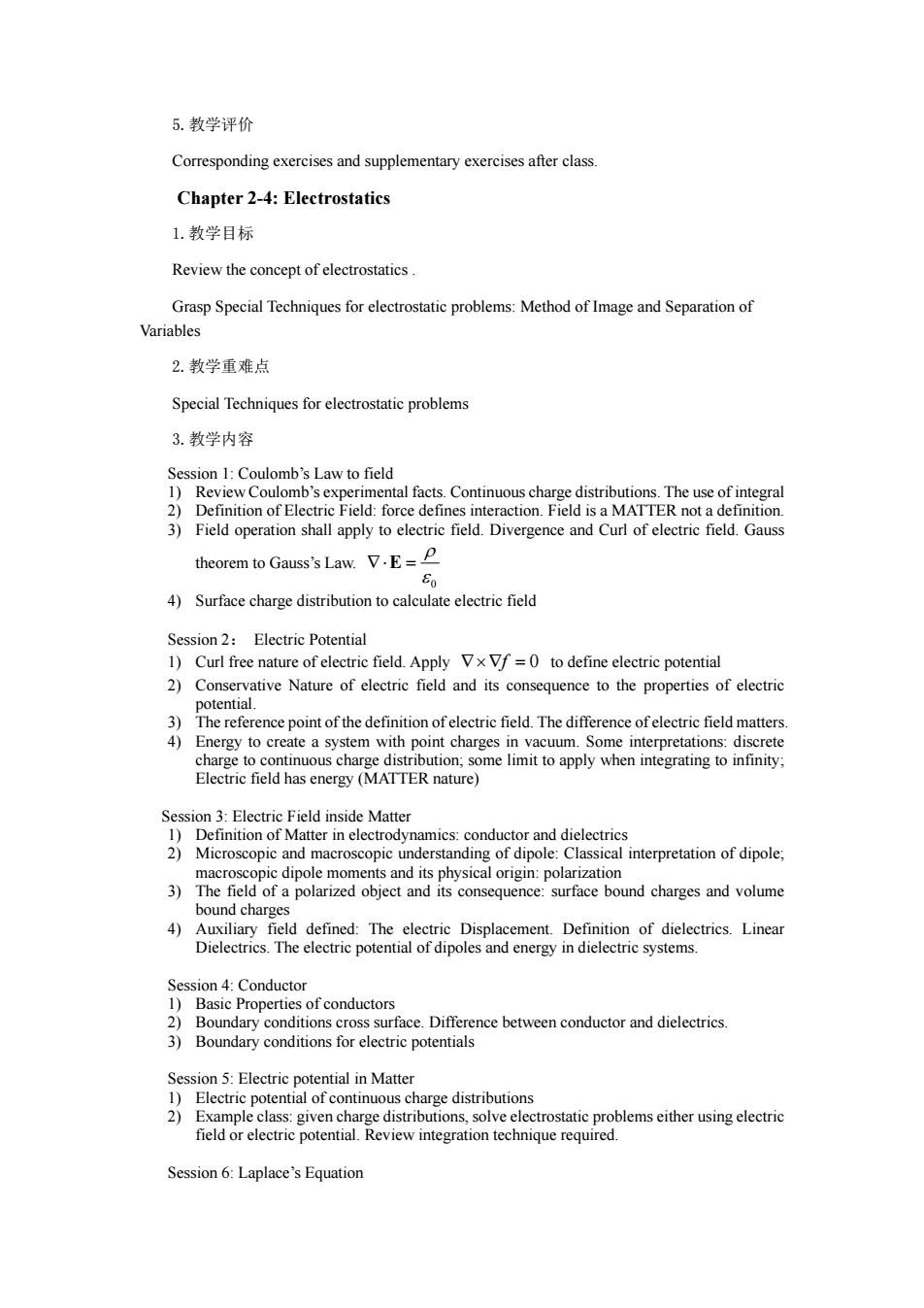
5.教学评价 Corresponding exercises and supplementary exercises after class Chapter 2-4:Electrostatics 1.教学目标 Review the concept of electrostatics Grasp Special Techniques for electrostatic problems:Method of Image and Separation of Variables 2.教学重难点 Special Techniques for electrostatic problems 3.教学内容 al facts Continuous ch e distributions The use of integral 3)Field operation shall apply to electric field.Divergence and Curl of electric field.Gauss theorem to Gauss's Law.V.E=P 4)Surface charge distribution to calculate electric field Session2: Electric Po 1)Curl free nature of electric field.Apply Vx=to define electric potential 2)Conservative Nature of electric field and its consequence to the properties of electric Thereference pont of thedefntionffield.Thefferefiematters 4)Energy to create a syste Electric field has energy (MATTER nature) :1 namics:conductor and dielectrics 2)Microscopic and macroscopic understanding of dipole:Classical interpretation of dipole ound charges and volume bound charg defined electric poten 2)Boundary conditions cross surface.Difference between conductor and dielectrics. 3)Boundary conditions for electric potentials Session 5 Flectrie notential in Matter ential of continuous charge distributions eopec eelCPabltemseiherusingelectnc Session 6:Laplace's Equation
5.教学评价 Corresponding exercises and supplementary exercises after class. Chapter 2-4: Electrostatics 1.教学目标 Review the concept of electrostatics . Grasp Special Techniques for electrostatic problems: Method of Image and Separation of Variables 2.教学重难点 Special Techniques for electrostatic problems 3.教学内容 Session 1: Coulomb’s Law to field 1) Review Coulomb’s experimental facts. Continuous charge distributions. The use of integral 2) Definition of Electric Field: force defines interaction. Field is a MATTER not a definition. 3) Field operation shall apply to electric field. Divergence and Curl of electric field. Gauss theorem to Gauss’s Law. 0 E 4) Surface charge distribution to calculate electric field Session 2: Electric Potential 1) Curl free nature of electric field. Apply f 0 to define electric potential 2) Conservative Nature of electric field and its consequence to the properties of electric potential. 3) The reference point of the definition of electric field. The difference of electric field matters. 4) Energy to create a system with point charges in vacuum. Some interpretations: discrete charge to continuous charge distribution; some limit to apply when integrating to infinity; Electric field has energy (MATTER nature) Session 3: Electric Field inside Matter 1) Definition of Matter in electrodynamics: conductor and dielectrics 2) Microscopic and macroscopic understanding of dipole: Classical interpretation of dipole; macroscopic dipole moments and its physical origin: polarization 3) The field of a polarized object and its consequence: surface bound charges and volume bound charges 4) Auxiliary field defined: The electric Displacement. Definition of dielectrics. Linear Dielectrics. The electric potential of dipoles and energy in dielectric systems. Session 4: Conductor 1) Basic Properties of conductors 2) Boundary conditions cross surface. Difference between conductor and dielectrics. 3) Boundary conditions for electric potentials Session 5: Electric potential in Matter 1) Electric potential of continuous charge distributions 2) Example class: given charge distributions, solve electrostatic problems either using electric field or electric potential. Review integration technique required. Session 6: Laplace’s Equation